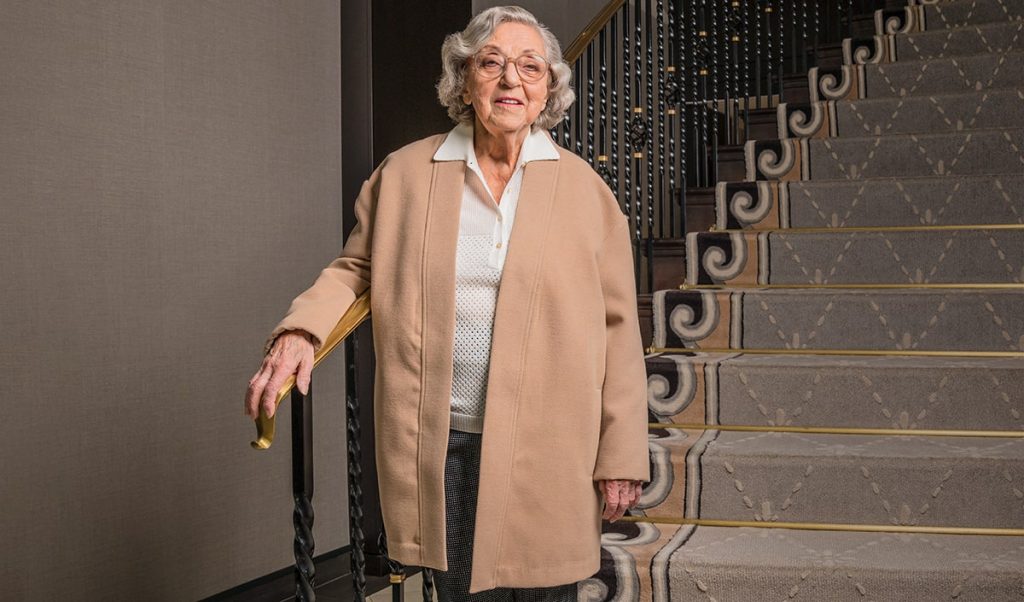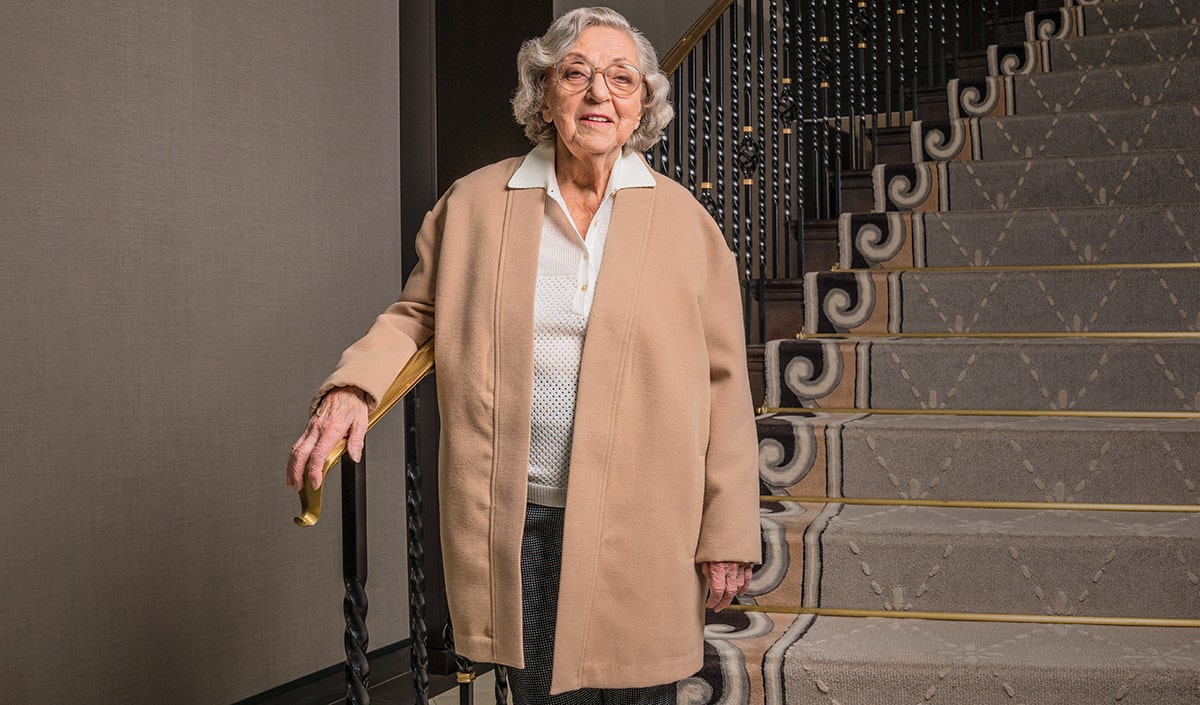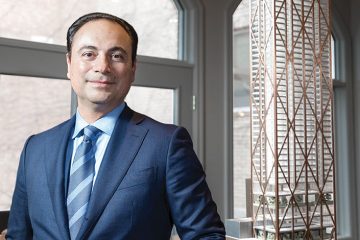Judy Cohen: Daunted But Undeterred
There are times in life when one hears about events so horrific that they can only describe them as ‘incredible’ or ‘unbelievable.’ Judy Cohen, a Holocaust survivor, shares what it was like to be a part of one of history’s blackest, most ‘unbelievable’ moments.
She was 15½ years old when the horrors began. Her 16th birthday was marked in Poland’s Auschwitz-Birkenau concentration camp, reportedly one of the worst Nazi death camps of the Second World War. There was, of course, no celebration, no cake, no balloons, no happy gathering of friends or presents from family members. In fact, Judy (Weissenberg) Cohen did not even know where some of her family members were — her parents, Margit and Sandor, or her brothers. Her sisters, Erzsebet, Klari and Evi, were in the camp with Cohen — their youngest sibling — and they surreptitiously whispered a “happy birthday” to her on that miserable September 17 day in 1944.
Describing herself as an everyday Jewish school girl, Cohen lived in Debrecen, Hungary, with her family and her six siblings. It was a religious life, one that is common to modern Orthodox Jews. “There was nothing extraordinary about me,” Cohen says. “I was in high school, in Grade 9, my father owned a store and my mother looked after our big family. Although we were not rich, we lived quite comfortably.
And while we Jewish citizens lived under the restrictions and edicts that were imposed by the Miklós Horthy regime starting in May 1938, our lives at that point were not in immediate peril.”
Mischievous and determined, Cohen shares some of her childhood memories in her new book A Cry in Unison, published by the Azrieli Foundation (September 2020). In one of the stories, Cohen reminisces about coming home one night and telling her parents that she’d eaten the ear of a pig at a friend’s house, because she was told that while the pig itself was not kosher, the ear was OK to eat, as it was on the outside of the pig.
The events leading up to the incarceration of Cohen, and the killing of 450,000 Hungarian Jews during the last 10 months of the Holocaust, were unequivocally insidious. All Jews were under strict orders to wear the Judenstern — a specified size, canary yellow Star of David that identified them as Jews. The removal and relocation of Jewish people from their homes and communities, to ghettos that were far removed from the general population, followed. Evacuees were allowed to take only the possessions that they could physically carry. What evolved — the deportation of a highly significant percentage of the Jewish population to what can only be described as a horrific, hard-to-believe nightmare to the Nazi concentration camps — was unimaginable and shameful. The names of these death camps, which are carved into history, and the prisoners’ identity numbers, which were carved into their arms, not to mention their souls, resonate: Auschwitz-Birkenau; Bergen-Belsen (where Anne Frank and her sister Margot died); Aschersleben, a slave-labour camp that was a sub-camp of Buchenwald; Belzec; Chelmno; Majdanek; Sobibor; and Treblinka.
On June 29, 1944, the Jews living in Debrecen — young, old and everyone in-between — were rounded up and shoved into cattle cars by Hungarian soldiers. Most of the young and fit Jewish adult males between the ages of 18 and 48, that is, all the husbands, fathers, sons and brothers, had already been conscripted into the Hungarian army’s slave labour units, including three of Cohen’s brothers. “Seventy-eight of us were jammed into one cattle car,” Cohen says. “Women carrying babies tried to find a place to sit down. My three sisters and I stood — it was incredibly hot. The atmosphere was ominous; there was a definite sense of dread in the air, that something quite frightening was about to happen.”
For The Longest Time, We (The Prisoners) Could Not Identify What The Unfamiliar, Incredibly Putrid Smell In The Air Was.
The trip lasted two or three days. With neither a calendar nor a watch, Cohen is unsure of how much time had passed. Seventy-eight people had to share one pail of water each day and also one pail into which they all defecated. It was an extremely hot time of year, and within a few hours the smell of both the frightened, sweaty hostages and the uncovered toilet pail were virtually unbearable.
“It is so very hard to describe,” Cohen says. “What I remember is the feelings — the frightening atmosphere. My father was a religious man, and he was praying, but I don’t even think he thought it would help.”
When the cattle car clattered to a halt, and the doors slid open at the Auschwitz-Birkenau concentration camp, Cohen remembers being relieved just to have the opportunity to breathe in some fresh air. But that moment did not last long.
The prisoners were hurriedly pushed into formation by two guards, who were yelling at them in Yiddish and German as they got ready to effect what was known as the “selection” process: a procedure that separated the young and healthy from the old and sickly. Cohen distinctly remembers an unusual occurrence, where a prisoner guard whispered quietly to the women who had babies in their arms, urging them to give their child to the grandmothers or the older women without telling them the reason. At the time she had no idea why. But decades later, through research, Cohen found out that these prisoner workmen, who were known as the Kanada Kommando, whose job it was to get all of the prisoners out of the cattle cars, knew that the grandmothers, children, babies and visibly pregnant women would be immediately killed in the gas chambers, an effective mode of killing people en masse — up to 700 people in 20 minutes — without impacting the mental and psychological well-being of their executioners. The young mothers who were not carrying their children would be saved — at least for the time being — for their hard-labour usefulness. “That was the intent of the Kanada Kommando — to save the lives of the young mothers,” Cohen says.
“For the longest time, we (the prisoners) could not identify what the unfamiliar, incredibly putrid smell in the air was,” Cohen says. “We found out, through rumours, that the gas chambers were killing people faster than the crematoriums could accommodate; they did not have the capacity to burn the large volume of bodies. So, the ‘surplus’ bodies that had been gassed were being burned in open pyres — that was the odour we inhaled day and night,” she says. “Realizing that we were inhaling the smell of all the people who had been murdered, including my parents, was devastating. How we kept going, we don’t understand that ourselves. But, we had few choices. We either committed suicide by throwing ourselves on the electrified fence, or we kept going as we struggled with the starvation, with the fear of being gassed any minute of the day or the fear of being separated by selections from our sisters or mothers.”
While Cohen and her sisters were together in the camp at the beginning, they were eventually separated during the selections by Nazi doctors. Dr. Mengele and some of his colleagues were the inspectors, and any sign that a prisoner was unwell signified the death knell for that person — they were slated for the gas chamber.
“I was the youngest of my four sisters, and when three of them were selected out of Birkenau, I was left alone. Eventually, however, while on a transport to another concentration camp, I met up with the Feig sisters — Edit and Sari — whom I knew well from Debrecen,” Cohen says. “I asked Edit and Sari if I could be their lagerschwester, their ‘camp sister.’ The answer was a quick and unhesitant ‘yes.’ They saw how sick, depressed and lost I was. They told me to stick with them, that they would look out for me. I wasn’t getting any medication. But somehow I got better. Being accepted as a third sister really helped me to survive.”
The cry in unison, for which Cohen’s book is titled, is a metaphor for the shared agony of hundreds of women prisoners in Birkenau, who “burst out in a cry — in unison” as one woman prisoner began to recite the “Kol Nidre” prayer on the most poignant of Jewish holidays, Yom Kippur. “This heart-rending sound has stayed with me all of my life,” Cohen says.
At some point in fall 1944, bad news, which was the very breath of Auschwitz, befell Cohen. She, along with a group of other prisoners, had been selected to be gassed. “I was extremely sick that day. I had a high fever and strong dysentery. I was totally out of it. A group of us were ordered to sit on the ground naked. The guards took away our clothing and my leather shoes, which were the only things that I still had from home,” Cohen reminisces. “I had no idea what was happening around me. And it was just as well that I didn’t know.”
In a miraculous turn of fate, Cohen was spared. In late December 1944, she volunteered to work at an airplane factory in Aschersleben, Germany. “It was the first time that I’d had the opportunity to make a decision as to where I was going,” Cohen says.
Conditions were marginally better at this new camp, a situation that gave Cohen hope that she could and would survive. However, after a huge bombardment one fateful evening, the factory where she was working was virtually destroyed. “There was no more work, and it was dangerous not having a job,” Cohen says. “We were told by high-ranking Nazi military officials that we had to leave the Aschersleben labour camp. We heard that there were orders to take us to the Buchenwald death camp to be executed. But the war was coming to an end, and those Nazi military leaders decided not to follow through on the execution order. Instead, we were sent on a forced march to nowhere (the march was approximately 100 kilometres), which ultimately turned out to be a death march,” she says. “We were given nothing to survive on, not even a drop of water to sustain us. We surreptitiously dug out whatever was growing by the sides of the road. We raided garbage cans when we went through small towns. I honestly don’t know how we even survived; although, many of us didn’t. There were 500 of us at the start, but by the time we were liberated, there were only about 200 of us left,” says Cohen. “It definitely helped that the three of us — the Feig sisters and myself — were together. If one of us failed — sat down or said that we couldn’t go any farther — the others would pick us up.”
“The Situation That I Was In, That I Experienced, Was So Brutal That It Is Hard For A Normal Human Being To Fathom That Another Human Being Could Do Those Things”
On a sunny Saturday in May 1945, Cohen and the rest of her group were liberated. They were told by the militia that if they took one road, a walk of 10 kilometres, they would meet up with the Soviets; the other road, which was six kilometres the other way, would take them to the American camp. The American camp was four kilometres closer, so Cohen chose that road. It was a decision, a choice, which would forever impact her future and success.
After the war, Cohen spent two years in the Displaced Persons (DP) camp in Bergen-Belsen, where she was reunited with her brother Laci and sister. Two of Cohen’s other sisters died from starvation. Of the seven Weissenberg children, only three survived the Nazi devastation. But, the DP camp provided food, medicine and the basic necessities of life, as well as skills training to the detainees. “We were born-again human beings,” Cohen says. “There were people from a myriad of countries, and we were all Jews connected by our religion and the Nazi selection. We talked incessantly about the Holocaust, the painful memories, the terrible stories that we had all experienced. But by the time we’d left the Displaced Person camp in Germany and settled down into a ‘normal’ life in Montreal, we no longer talked about it,” she says. “People were simply not interested. They had their own complaints, which seemed inane: how they didn’t have enough butter and other such things during the war, which, compared to the unimaginable suffering of the Holocaust, were hard to sympathize with.” Life questions abounded for Cohen and her siblings: “Where were they going to go when they left the DP camp? How were they going to move on from not only where they had been, but also from what they had experienced? How were they ever going to repair the tears in their soul?”
While Sweden and France welcomed Jewish immigrants, it was not until 1947–48 that Canada opened its doors to Jewish survivors of the Holocaust. “I experienced all of the difficulties that other immigrants do, with the language and life skills being the first ones. But, there was also the emotional and psychological scars to deal with as a survivor of the Holocaust,” Cohen says. “No one wanted to hear about our stories; no one had the time to listen. But, in 1961, when Adolf Eichmann, a German Nazi high-ranking official and a major Holocaust organizer, went on trial in Israel, the whole issue came to the surface again, with all its horrors and complexities. Survivors of the Holocaust became living witnesses and public speakers about the atrocities they experienced.”
Cohen and her sister and brother went on to live what she describes as a normal, successful and even happy life. She met her husband, Sidney, in 1959 when she was 32. They had two children, Michelle and Jonathan. “Sidney was Canadian-born,” Cohen says. “So we didn’t speak a great deal about my experiences in the camps or the Holocaust. I didn’t want to frighten my children, either, so I was very careful and sensitive to their ages when telling them about the Holocaust. I did not want them to be afraid to be Jews.”
After she retired from work, Cohen became a public speaker, sharing her experiences around the Holocaust. Recognizing that women were an important part of the resistance, both during the war and during the Holocaust, Cohen made the decision in 2000 to launch a website to tell their stories. “All Jews suffered from the racial issue of being Jewish,” Cohen says. “But, nobody at that point had thought of it in terms of gender. Then, scholars started to read some of the Holocaust memoirs written by women and found that they had suffered different horrors than men. The fact that women would have babies and carry on the Jewish lineage was a threat to the Nazis,” she says. “Females had to be destroyed — every pregnant woman — and that is what the Nazis set out to do.” Cohen became quite interested in this particular issue, and with the help of Jonathan she created a website in 2001, Women and the Holocaust: A Cyberspace of Their Own (www.theverylongview.com), to bring the story of women who survived and of those who did not to the forefront, highlighting the specific extreme cruelty and the violence that took place in the death camps. The website is meant to be a bridge between academia and the general public, especially students, with the ultimate intention of being a strong teaching aid.
Feisty, determined and with a crystal-clear memory for both dates and details, Cohen, who turned 92 on September 17 of this year, just one day shy of the start of Rosh Hashanah, has denied the Nazis the exact things that they ached to take from her: a zest for life and a passionate voice that keeps the world informed, cognizant of what happened to Jewish people and prisoners during the Second World War. She is also passionately vocal as to what is happening with both Holocaust naysayers and those who are driven by prejudice. Cohen has been an unfailing champion of bringing awareness to the violence and suffering that women endured in the Nazi camps. She has spoken at conferences and networked with scholars and survivors, inviting them to be vocal and to share their stories. And Cohen is vocally chagrined that Fascism has become fashionable in so many countries.
“I can see from what is going on in the world today — some countries, in particular — just how the Nazis were able to gain power all those years ago. The incessant propaganda and the destructive elements in society are being encouraged to spew their hatred and advocate for intolerance, nationalism and religious discourse,” Cohen says. “So many hate groups have evolved, and people are identifying with them. Ethnic animosities are being ignited again. Nobody is learning — the power-brokers, the ones who make the major decisions — have not learned from the Holocaust. The lesson of the Holocaust is not the horrors, per se; the relevant lesson is about the political, social and judicial processes that evolved into the path that led to Fascism, Nazism and eventually to the gas chambers,” she says. “Once citizens are deprived of basic human rights, it is a spiral that evolves into more injustices; ideologies are accepted and civil societies acquiesce. But, when the populace objects, there is an awareness as to what is happening. In the end, it is about the democratic process,” says Cohen. “The situation that I was in, that I experienced, was so brutal that it is hard for a normal human being to fathom that another human being could do those things.”
















































































